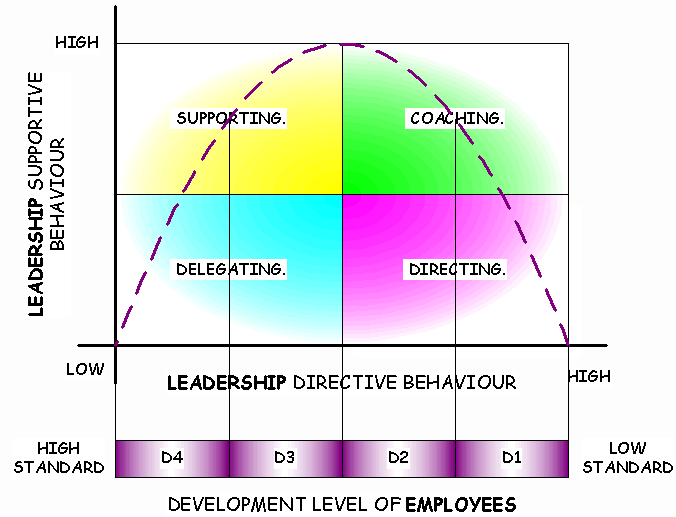Inspiration comes when you least expect it! If you followed some of my earlier posts, you may remember that I have had a problem trying to figure out how much direction and assessment to give students, verses the amount of independence provided to build their own learning environment and sense-making systems. Last night, an old model presented its self to me. My partner went back to school for a nursing degree and is currently in a leadership class. He asked me if I could explain a leadership model presented in his book. After a few minutes trying to figure out what he was talking about, I realized that it was the situational leadership model. If I remember correctly, this came into vogue around the early 70's; I first came across it in the late 80's. My partner's textbook did a horrible job explaining the principles (very bizarre and negative examples), so I started talking him through the basics. Bill has a master's degree in English literature, so he is very familiar with education, so I started building a model of situational leadership between a teacher and a student. That is when inspiration struck!
I'm not sure how familiar readers may be with the model of situational leadership, so I'll go through a part of it, and provide a few links to help explain it further. The core idea is that the relationship between a leader and a follower (in this case teacher and student) is situational, meaning that it is based upon the level of maturity, skill and responsibility of the follower. There are two metrics: Task and Relationship. The task is how much direction the leader must provide for the follower to complete the task. The relationship is the amount of two-way communication needed in the course of the task. Two metrics combined, provides four situations and four development/maturity levels.
The S1 condition is one where you have a person whose skill level is low for task competition (D1). So the leader has to provide detailed direction and oversight. In education (US), the equivalent would be an elementary school or middle school teacher helping a student learn how to write or do math. You have to direct their learning.
The S2 condition is one where the person has growing skill, but they may not have the confidence in their ability and/or need refinement of their skills (D2). In this case, the leader has to develop a two way communication with the follower, and take on a coaching role to build their confidence and skills. In education (US), this would be high school and early college (hopefully). This would be where you have the transition of a lecturer becoming a mentor, as you leave the directive and enter into communication.
The S3 condition is one where the person has the skill, but still needs some oversight. It may be an issue of confidence, but I think of this situation as more of refinement (D3). In this case you don't have to worry about the skill, it is more about the final product. While the diagram above calls it supporting, I see it more as a collaboration. In education, this would be graduate school, where the student has the knowledge and skills, but needs to refine their work to a higher academic standard. That is where the major professor and graduate committee come in. Their role is give the student the room to grow, but be there as needed.
The difference between S2 and S3: In S2, the leader/teacher is the one who initiates the two way communication. In S3, it is the follower/student that initiates the communication; this shows a growing independence.
In S4, the follower has the skills and confidence required to be handed a project by the leader, and the leader knows that the project will be completed to specifications (D4). In education, this is where you have your academics.
The following is a quote from Situational Leadership®.
Once a task is defined, each individual on the team is objectively assessed for Performance Readiness®, giving the leader the ability to fully optimize each individual’s contribution to the team effort. Situational leaders lead individuals who happen to be part of a team, rather than leading a team that happens to contain individuals.
This quote was when I had my moment of inspiration: "To lead students who happen to be part of a class, rather than leading a class that happens to contain students."
A simple transition, but a powerful one for me to consider. Added to that is the idea that I am looking at students who start out at different developmental levels. Most of my students in Principles of Biology will be at the D2 stage, but I will have some D3 students. Noting that, I can prepare and distribute a lot of supplemental resources, assess students and proscribe learning modules that will help them (coaching). For the students that are already motivated, I can work with them on a more collaborative/supportive level.
Where do MOOCs fall? I put them firmly in S4, where you have D4 participants. I don't think we can expect this level from college freshmen and sophomores just yet. Some junior classes, and most senior levels classes though could fit into the MOOC model.
Oh, almost forgot the link for a good overview of situational leadership: http://www.12manage.com/methods_blanchard_situational_leadership.html

No comments:
Post a Comment